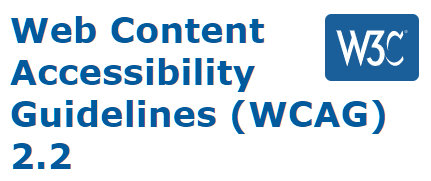
The Worldwide Web Consortium (W3C) Web Accessibility Initiative (WAI) is finalizing the latest version of the Web Content Accessibility Guidelines (WCAG). Web Content Accessibility Guidelines 2.2 (WCAG 2.2) extends WCAG's layers of guidance by adding new success criteria focused on making web content more operable and understandable. These changes will be particularly beneficial for users with visual, mobility, and cognitive disabilities.
WCAG 2.2 is currently at the Candidate Recommendation stage and will be finalized soon. This blog post from Knowbility Digital Accessibility Specialist Melissa Green is the first in a series examining the new success criteria. "What's New in WCAG 2.2?" is also the topic of Knowbility's next Be A Digital Ally session, Thursday, December 15, 2022 at 5 PM Central Time (US and Canada). Register for December BADA through Humanitix.
The Web Content Accessibility Guidelines – An Introduction
The Web Content Accessibility Guidelines (WCAG) provide standards for web content accessibility and document how to make web content accessible to people with disabilities. Primarily intended for a technical audience, the WCAG standards have 13 guidelines organized under four principles: Perceivable, Operable, Understandable, and Robust (collectively referred to as "POUR"). Each guideline has success criteria, testable statements that are not technology-specific. The success criteria determine "conformance" to WCAG. In other words, to meet the guidelines, the content needs to meet the success criteria. The success criteria are at three levels: A, AA, and AAA, with Level A as the minimum level of conformance and Level AAA conformance ensuring access to the broadest possible audience.
The Worldwide Web Consortium (W3C) Web Accessibility Initiative (WAI) develops WCAG's technical documents, including the standards/guidelines themselves and references and guides for applying them.
These are the documents for the W3C WAI’s WCAG 2.2 Draft:
- WCAG 2.2 Draft: Candidate Recommendation expected to be finalized in early 2023.
- WCAG 2.2 Supporting Documents
- How to Meet WCAG 2.2: A customizable quick reference to WCAG 2.2 that includes guidelines, success criteria, and techniques for authors to use as they are developing and evaluating web content. The reference includes content from WCAG 2.0, 2.1, and 2.2, and authors can filter in many ways to help them focus on what is relevant.
- Understanding WCAG 2.2: A guide to understanding and implementing WCAG 2.2. There is a short "Understanding" document for each guideline and success criterion.
- Techniques for WCAG 2.2: A collection of techniques and common failures, each in a separate document that includes a description, examples, code, and tests.
- The WCAG Documents: A diagram and description of how the technical documents are related and linked.
WCAG 2.0, 2.1, 2.2 and ... 3? WCAG Past & Future
The Web Content Accessibility Guidelines (WCAG) are developed through a process incorporating community input and consensus development. In the W3C process, Working Groups create specifications and guidelines that undergo multiple rounds of review and revision before W3C publishes them as a Recommendation. Because the standards are stable and referenceable, they do not change after publication. WCAG 2.0 was published in 2008, followed by WCAG 2.1 in 2018.
The Accessibility Guidelines Working Group (ACWG) is finalizing the latest version of the Web Content Accessibility Guidelines, WCAG 2.2. WCAG 2.2 is at the Candidate Recommendation stage of the process, and we expect it to be finalized in early 2023.
Another version of WCAG is also in the works! Information about and an early draft of W3C Accessibility Guidelines WCAG 3.0 (formerly known as "Silver") is available on the W3C/WAI site: WCAG 3 Introduction.
WCAG 2.2 – What's New
While WCAG 2.2 is not yet an official Recommendation, the latest published version and W3C WAI's What's New in WCAG 2.2 Draft give us an idea of what to expect. We anticipate nine new success criteria in WCAG 2.2 (links from W3C WAI):
- Accessible Authentication
- Accessible Authentication (No Exception)
- Consistent Help
- Dragging Movements
- Focus Appearance
- Focus Not Obscured (Enhanced)
- Focus Not Obscured (Minimum)
- Redundant Entry
- Target Size (Minimum)
WCAG 2.2 includes all success criteria from WCAG 2.0 and WCAG 2.1 with no changes to existing criteria. However, one success criterion has changed level. 2.4.7 Focus Visible, Level AA in WCAG 2.1, is a Level A criterion in WCAG 2.2.
WCAG 2.2 builds on WCAG 2.1, and they are backward compatible: web pages that conform to WCAG 2.2 also conform to WCAG 2.1, which should also conform to WCAG 2.0. If you are required to conform with WCAG 2.0 or 2.1, you can update content to WCAG 2.2 without "breaking" conformance with previous versions.
WCAG 2.2 Resources
Knowbility will provide a high-level overview of the new success criteria in our next Be A Digital Ally session, "What's New in WCAG 2.2?", December 15, 2022 at 5 PM Central Time (US and Canada). Register for December BADA through Humanitix. Keep an eye on our website and social media for more in-depth blog posts, webinars, and other WCAG 2.2 learning opportunities.
Resources from the W3C Web Accessibility Initiative:
- WCAG 2.2 Draft: Latest published version of WCAG 2.2. Currently at the Candidate Recommendation stage, we expect WCAG 2.2 to be finalized in early 2023.
- What's New in WCAG 2.2 Draft: Explanation of the proposed new success criteria with examples.
- WCAG 2.2 Supporting Documents: Quick references, guides, and techniques for understanding and meeting WCAG 2.2
- WAI Resources: This page lists W3C WAI technical and educational resources and should be updated to include WCAG 2.2 following its publication as a recommendation.
